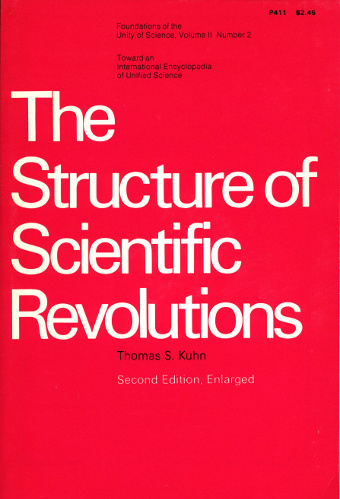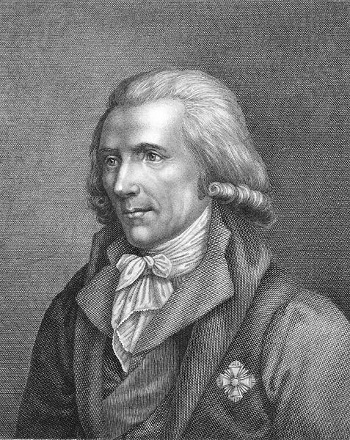Fifty Years of Paradigm Shifting
February 25, 2013
Following the
dictum attributed to Mark Twain, that you shouldn't let your
schooling interfere with your
education, I read a lot of
extracurricular items while in
graduate school. As all
students know, even their chosen
profession is not as exciting as they had once thought, so they look elsewhere for enlightenment.
 One book I thoroughly enjoyed was Thomas Kuhn's, "The Structure of Scientific Revolutions," published in 1962, when I was still in high school.[1] I read the book nearly a decade after it's publication, but its observations about the scientific method still had the ring of truth. At the very least, it added the word, "paradigm," to my vocabulary.
One book I thoroughly enjoyed was Thomas Kuhn's, "The Structure of Scientific Revolutions," published in 1962, when I was still in high school.[1] I read the book nearly a decade after it's publication, but its observations about the scientific method still had the ring of truth. At the very least, it added the word, "paradigm," to my vocabulary.
(The cover of my second edition of Kuhn's book. Barely readable is the price, $2.45, which is even less than the price of most eBooks, today.)
The main point of Kuhn's book is that there are two types of science. One science, "normal" science, is what I and most of my colleagues did daily in our
laboratories. The things we did were "by the book," and the few surprises were from lack of
experimental control or a misunderstanding of which page of the "the book" we were on.
Kuhn's other type of science was "revolutionary" science. Unlike normal science, revolutionary science challenges the wording in "the book," and leads to a different way of thinking about
nature. A few examples would be the
heliocentric solar system,
quantum theory, and
relativity. The idea of paradigm enters when we consider the interaction between normal and revolutionary science.
Normal science works within a paradigm, defined as the collection of truths shared by a particular group of
scientists. I would often glance at the
periodic table on my laboratory wall for guidance, and the many
chemical notions embedded in that table are a paradigm. If someone were to tell me about some work on an
element between
hydrogen and
helium, I wouldn't believe him.
The problem with paradigms, as Kuhn pointed out, is that ideas outside the paradigm (such as the element with an
atomic number between one and two, above) are rejected by the normal scientists without their giving them much thought. Thus, scientific papers demonstrating results outside the paradigm are rejected by
journal referees. One example is
Dan Shechtman's quasicrystals.
As I reported in a
previous article (The 2011 Nobel Prize in Chemistry, October 7, 2011), it took two years for Shechtman to get his paper on quasicrystals accepted for publication. The reason for rejection was obvious to those working in the current
crystallographic paradigm. The
icosahedral point group symmetry discovered by Shechtman wasn't possible. Crystallography forbids 5-fold
symmetry, since a lattice like that is not uniform under
translation.
Eventually, more examples of quasicrystals appeared, including some that were dismissed by their discoverers as being "wrong" when they discovered them, and buried in some drawer without publication. Finally, in 1992, the
International Union of Crystallography changed its definition of a crystal from "a regularly ordered, repeating three-dimensional pattern" to a solid with a "discrete diffraction diagram."[3] Shechtman was awarded the 2011
Nobel Prize in Chemistry.
What happened in the quasicrystal case, as in other scientific revolutions, is that the essential paradigm in a scientific field was changed. As if there weren't enough "shifts" in
physics already (
Doppler shift,
Lamb shift,
phase shift,
redshift, etc.), Kuhn promoted this idea of a
paradigm shift. Kuhn argued that when little inconsistencies start to pile up in a paradigm, scientists become more aware that things are not quite right. Finally, someone comes along with a new paradigm that sets things straight.
Some of the Old Guard will have a hard time adjusting to the new paradigm, but the logic of science prevails, and everyone shifts to the new paradigm. The old paradigm, say
phlogiston, is now considered wrong, and everyone buys into the new paradigm,
caloric theory, which is then superseded by the next paradigm, the
mechanical theory of heat. Paradigm shifting often takes a lot of time.

Benjamin Thompson,
Count Rumford
Thompson, who saw the heat generated while boring cannon, did some careful measurements. He published his results as "An Experimental Enquiry Concerning the Source of the Heat which is Excited by Friction."
Thompson's experiments demonstrated the mechanical equivalent of heat.
(Via Wikimedia Commons))
Kuhn wrote that there's resistance to paradigm shift because paradigms are
incommensurate; that is, they can't be directly compared, since they talk about different things. You can't go in a straight line of reasoning from
Newtonian mechanics to relativity.
Although scientists can see the truth about paradigms, they are usually resistant to the notion of
incommensurability. In their minds, the old paradigm was dumped because it was wrong, and the new paradigm was accepted because it was right. They carry their own idea of a valid comparison, usually relating to agreement with experiment, in their mind.
Kuhn has a rightful place in
twentieth century history of science, alongside
George Sarton,
Gerald Holton and
Karl Popper. My article presented a thumbnail sketch of Kuhn's ideas from a scientist's viewpoint. Matthew C. Rees has a recent article in
The New Atlantis that looks at Kuhn from a
philosophical standpoint.[4]
References:
- Thomas S. Kuhn, "The Structure of Scientific Revolutions: 50th Anniversary Edition," University Of Chicago Press (Fourth Edition edition, April 30, 2012), ISBN-13: 978-0226458120, 264 pages (via Amazon).
- D. Shechtman, I. Blech, D. Gratias and J.W. Cahn, "Metallic phase with long range orientational order and no translation symmetry,", Physical Review Letters, vol. 53, no. 20 (November 12, 1984), pp. 1951-1953.
- Kenneth Chan, "Israeli Scientist Wins Nobel Prize for Chemistry," The New York Times, October 5, 2011.
- Matthew C. Rees, "The Structure of Scientific Revolutions at Fifty," The New Atlantis, no. 37 (Fall 2012), pp. 71-86.
Permanent Link to this article
Linked Keywords: Dictum; Mark Twain; curriculum; education; extracurricular; graduate school; student; profession; Thomas Kuhn; The Structure of Scientific Revolutions; high school; scientific method; paradigm; eBook; science; laboratory; experiment; experimental; nature; heliocentrism; heliocentric solar system; old quantum theory; quantum theory; relativity; scientist; periodic table; chemistry; chemical; chemical element; hydrogen; helium; atomic number; scientific journal; scholarly peer review; referee; Dan Shechtman; quasicrystal; crystallography; crystallographic; icosahedral point group symmetry; symmetry; translation; International Union of Crystallography; Nobel Prize in Chemistry; physics; Doppler shift; Lamb shift; phase shift; redshift; paradigm shift; phlogiston theory; phlogiston; caloric theory; theory of heat; mechanical theory of heat; Benjamin Thompson, Count Rumford; heat; boring; cannon; An Experimental Enquiry Concerning the Source of the Heat which is Excited by Friction; mechanical equivalent of heat; Wikimedia Commons; Commensurability; incommensurate; classical mechanics; Newtonian mechanics; incommensurability; twentieth century; history of science; George Sarton; Gerald Holton; Karl Popper; The New Atlantis; philosophy; Thomas S. Kuhn, "The Structure of Scientific Revolutions: 50th Anniversary Edition," University Of Chicago Press (Fourth Edition edition, April 30, 2012), ISBN-13: 978-0226458120.